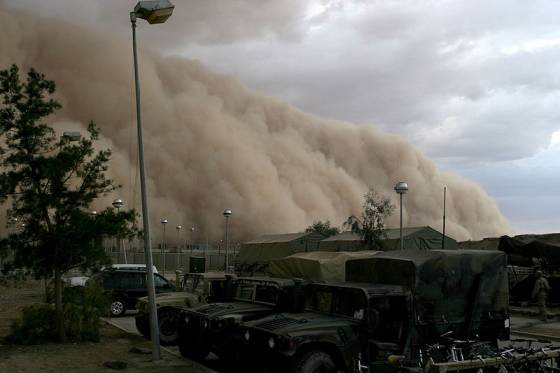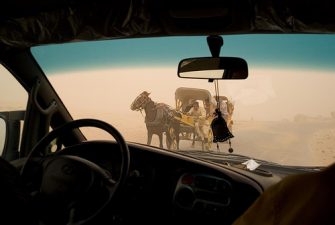Earth’s dust storms and sand storms are becoming more frequent. How does that affect your health?
Here in the Middle East, powerful hot winds sometimes drop fine yellowish sand down from the sky, coating the skin and lips irritatingly and making it hard to see across the street. It’s the lashing tail of giant storms in the Sahara.
Invading sand has already caused airport shutdowns in Israel. Radio announcements warn pregnant women, the elderly and people with heart disease or respiratory conditions to stay inside. Babies and young children must remain indoors too. It’s difficult enough to contend with air pollution, but sand storms aggravate everyone.
Even in ordinary weather, plain household dust settles in a visible layer on anything lying around, within a day. Studies conclude that there really is more dust in the atmosphere. But any careful housewife can tell you that.
According to Wikipedia, the Sahara desert is a key source of dust storms.
Saharan dust storms have increased approximately 10-fold during the half-century since the 1950s, causing topsoil loss in Niger, Chad, northern Nigeria, and Burkina Faso. In Mauritania there were just two dust storms a year in the early 1960s, but there are about 80 a year today, according to Andrew Goudie, a professor of geography at Oxford University.[6][7]
A study at Cornell Unversity conducted in January 2011 by Natalie Mahowald, professor of Earth and atmospheric sciences, reports doubling of the amount of dust in our atmosphere in the last century.
Dr. Mahowald writes:
Desert dust and climate influence each other directly and indirectly through a host of intertwined systems. Dust limits the amount of solar radiation that reaches the Earth, for example, a factor that could mask the warming effects of increasing atmospheric carbon dioxide. It also can influence clouds and precipitation, leading to droughts; which, in turn, leads to desertification and more dust.
New studies show that dust storms affect weather in many ways. Those giant African dust clouds whose backlash we feel in the Middle East reflect sunlight and cool the atmosphere under them. In their original regions, this may influence the development of local storms into hurricanes that cross the ocean and reach the Americas.
Climate change, conversely, affects the occurrence of dust storms. At the University of Arizona in Tuscon, Jessica Conroy presented a study on increased dust storms in the Tibetan plateau. According to Conroy, global warming creates an atmospheric phenomenon known as “Arctic Oscillation in a positive phase” that drives stronger, hot winds across the region.
“It’s going to continue to be dusty in this region, and dust can accelerate the melting of the glaciers in the Himalayas,” says Conroy.
Layers of dust darken the white ice, absorbing the sun’s radiations like solar panels and causing the glaciers to melt and evaporate at a much more rapid rate than before. These glaciers provide water for millions of people across Asia.
As in the Himalayas, so in other parts of the world. In the recent decade, sand storms of historical proportions have affected Texas, Arizona , Australia and New Zealand, Pakistan, China, Bahrain and Saudi Arabia.
And dust. It’s more than a household nuisance. It’s a threat to everyone. It clogs up car engines and air conditioners on land, and satellite mechanisms in outer space. It can dangerously reduce visibility for air traffic and drivers.
Stinging eyes are the least of bad reactions to dust and sand storms. Continued exposure to air with over 300 particles per cubic meter may result in allergic reactions, chronic breathing difficulty and heart disease. Inhaling dust can block sinuses and create respiratory conditions that germs love.
What should you do if a dust/sand storms hits your area?
- Stay indoors.
- If asthmatic or with any chronic breathing difficulty, do not exercise. Use the breathing relief methods you know and are used to.
- Close windows and turn the air conditioning on (this being a time when using it is justified). Make sure the air filters are clean.
- If serious breathing difficulties or chest pain develop, get medical help.
More on air quality in the Middle East:
- Cleaner Air in Northern Israel
- Compact Cities Can Reduce Air Pollution
- “Black Cloud Season” in Egypt
- Rooftop Gardens Scrub The Air in Egypt
Photo of sand storm approaching Al Asad, Iraq from Wikipedia.





Ever hear of the movie Dune?
All that’s missing from the above scenario are the worms.
Dust storms will not be the worst problem on this planet now so heavily polluted it is near the limit of its endurance. If the corporate CEOs ignore the warning from the Rio Summit meeting in Brazil, their businesses will collapse along with all other life forms as the biosphere degenerates beyond its abillity to support any living things, and of course everyone on Earth will die, and the Earth will join Mars and Venus as totally devoid of life.
The only effective solution is to safely recycle 100% of all human-generated waste materials, and peacefully reduce the human population with family planning education. Then, the planet could heal itself as its natural processes were allowed to continue, with our help.